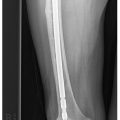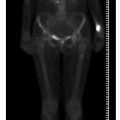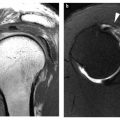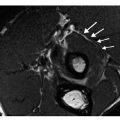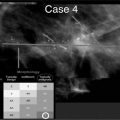J. Hodler, G. K. von Schulthess and Ch. L. Zollikofer (eds.)Musculoskeletal Diseases 2013–2016Diagnostic Imaging and Interventional Techniques10.1007/978-88-470-5292-5_16
© Springer-Verlag Italia 2013
Inflammatory Disorders of the Spine
Victor N. Cassar-Pullicino1
(1)
Department of Radiology, The Robert Jones and Agnes Hunt Orthopaedic Hospital, Oswestry, UK
Abstract
The underlying pathology of target organs in spinal inflammatory disorders dictates the imaging appearances throughout the natural history of the disease processes. Although overlap exists, inflammatory disorders can predominantly affect the synovial articulations of the spine (rheumatoid disease) or primarily the enthesis of ligaments and intervertebral discs (seronegative spondyloarthropathies). The various disease states are not static but rather need to be viewed as dynamic and progressive, usually resulting in complications. In rheumatoid disease it is primarily the cervical spine that is involved, but it is very rare that the rheumatoid arthritis patient presents with cervical spine manifestations as the first mode of presentation. On the other hand seronegative spondyloarthropathies usually present with axial manifestations of enthesitis as the first mode of presentation, and these are easily overlooked.
Introduction
The underlying pathology of target organs in spinal inflammatory disorders dictates the imaging appearances throughout the natural history of the disease processes. Although overlap exists, inflammatory disorders can predominantly affect the synovial articulations of the spine (rheumatoid disease) or primarily the enthesis of ligaments and intervertebral discs (seronegative spondyloarthropathies). The various disease states are not static but rather need to be viewed as dynamic and progressive, usually resulting in complications. In rheumatoid disease it is primarily the cervical spine that is involved, but it is very rare that the rheumatoid arthritis patient presents with cervical spine manifestations as the first mode of presentation. On the other hand seronegative spondyloarthropathies usually present with axial manifestations of enthesitis as the first mode of presentation, and these are easily overlooked.
Synovial involvement of the cervical spine in seropositive inflammatory states has a predilection for the facet joints, and in particular the C1-C2 articulations. In seronegative spondyloarthropathy, the inflammatory site is the enthesis where the collagen of the ligaments or intervertebral disc annulus enters bone directly. The cause of the inflammatory process is the generation of cytokines, which results in edema, bone erosion, disorganization of bone and ligament structure, which promotes a reactive osteitis and eventually ossification of the ligaments commencing at the enthesis interface. Histologically, the inflammatory enthesitis reveals a macrophage-predominant cellular infiltrate consistent with the knowledge that tumor necrosis factor (TNF)-α, which is a pro-inflammatory cytokine produced by macrophages, plays a key role in the inflammatory spondyloarthropathies. The seronegative spondyloarthropathies can be further categorized based on the imaging findings equated to the clinical features and laboratory findings. Although multiple modalities such as radiography, computed tomography (CT) and scintigraphy can be employed to assess the inflammatory sites within the axial and the appendicular skeleton, it is primarily magnetic resonance imaging (MRI) that is the optimal imaging modality to assess inflammatory disorders of the spine because of its high sensitivity and specificity. Although contrast-enhanced magnetic resonance (MR) studies are not usually required for diagnosis, they can distinguish between active and inactive disease and also help in assessing the response to anti-inflammatory therapy.
Clinical Features
The etiology of the inflammatory spondyloarthropathies is still unknown, although the human leukocyte antigen (HLA-B27) is found to be present in 90% of patients suffering from ankylosing spondylitis, 50% patients with reactive arthritis (previously known as Reiter’s syndrome) and only 20% of patients with psoriasis. Inflammatory back pain that is worse at night and in the early morning is the key clinical hallmark of inflammatory spondylo — arthropathy. Ankylosing spondylitis usually presents with early morning stiffness that is eased by movement and exercise. However the onset is usually insidious allied with multiple relapsing episodes of back pain that usually starts in the lumbar spine. The condition can remain undiagnosed for years, resulting in fusion of the spine, which renders the condition painless. Although classification subtypes have evolved over the last 30–40 years, the main challenge facing the radiologist is the early diagnosis of inflammatory spinal disorders because the early institution of therapy can limit disability and diminish disease progression. MRI has not only helped in the early detection of disease, but also is increasingly being employed in scoring mechanisms that without doubt will be incorporated in time in decision-making therapeutic protocols.
Sacroiliitis
Sacroiliitis is the hallmark of all spondyloarthropathies. It is a fundamental component required in establishing the diagnosis of ankylosing spondylitis, but it is also relevant to the other spondyloarthropathies. In ankylosing spondylitis it is bilateral and symmetrical, while in psoriatic spondyloarthropathy and reactive arthritis it can be bilateral or unilateral. Involvement of the axial skeleton is unusual and indeed rare in the absence of sacroiliitis.
Conventional radiography remains the initial diagnostic imaging modality recommended despite its low sensitivity and relatively high false-negative rate in early disease. There are inherent limitations to the proper radio – graphic assessment of the sacroiliac joints; these arise because the joints themselves are divergent in the anteroposterior projection, which is why a posteroanterior projection is usually a better option of assessing the sacro — iliac joints. It is also well known that conventional radio — graphy can miss advanced sacroiliitis. Early inflammatory sacroiliitis can result in a loss of the sharpness of the subchondral bone outline of the joint; this then progresses to becoming irregular due to the presence of erosions, and this in turn produces an appearance of localized joint widening. Sclerosis of the subchondral bone on either side of the joint is fairly diagnostic in established disease, especially when it involves the inferior and middle portion of the joint and is more pronounced on the iliac side. However, in established disease, the sacroiliac joint can also exhibit loss of sharpness due to ossification across the joint leading to ankylosis. The modified New York criteria have identified five radiographic stages of sacroiliac joint involvement:
Grade 0: no abnormality
Grade 1: suspicious changes
Grade 2: sclerosis with early erosions
Grade 3: severe erosions, pseudo joint widening and partial ankylosis
Grade 4: complete ankylosis.
In practice, however, radiological detection of these changes is challenging with poor interobserver and intraobserver reliability for the changes in early disease, namely stages 1 and 2.
The relatively late development of radiographic changes in ankylosing spondylitis is undeniably one of the factors that can delay the diagnosis. However, MRI has revolutionized the early diagnosis of sacroiliitis. This is primarily dependent on the pericartilage osteitis, which is an important feature of ankylosing spondylitis and produces bone marrow edema that is well picked up on the edema-sensitive sequences such as T2-weighted sequences with fat suppression or the short tau inversion recovery (STIR) sequence. T1-weighted spin-echo sequences are, however, better at depicting articular erosions. The degree of the edema can vary, ranging from florid, fairly extensive areas of periarticular edema to more focal and localized zones of edema paralleling the joint line. It is usually the inferior iliac portion of the joint that is involved in the early stages of sacroiliac inflammatory change. Gadolinium-enhanced MR studies have been advocated in active disease, as there is a rise in the MR signal at the point of enhancement in the joint space and periarticular tissues in the first 2 min. However, contrast enhancement is particularly useful if the edema-sensitive sequence (STIR) is equivocal. Using contrast enhancement, MRI can not only distinguish active from inactive disease, but it can also monitor the treatment response where a decrease in the enhancement even in the persistent presence of bone marrow edema has been shown to be strongly correlated with a good clinical response to treatment. There are various ways of utilizing post-contrast MRI in the assessment of sacroiliac disease. They are particularly helpful in determining whether the instituted drug regime is working, identifying a need to alter the drug regime, and deciding to stop drug regimes if they are not working in view of the significant side-effects and high cost.
Stay updated, free articles. Join our Telegram channel

Full access? Get Clinical Tree


